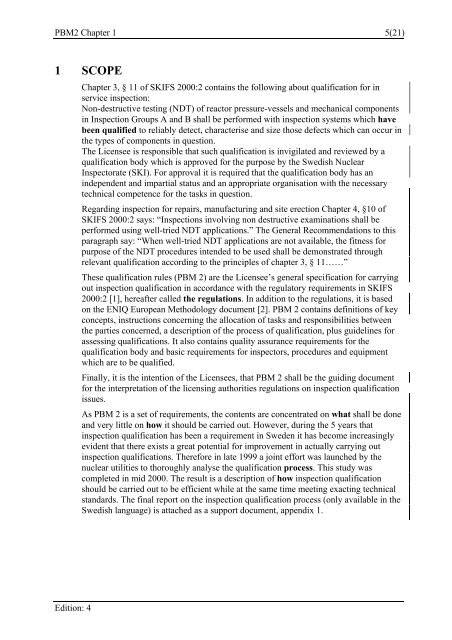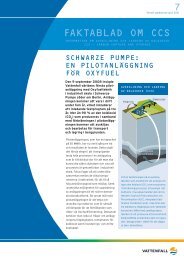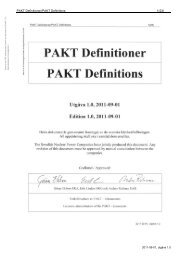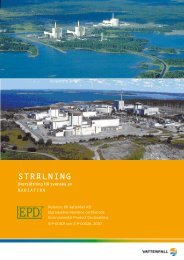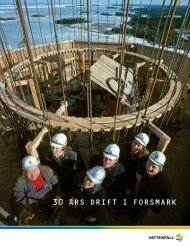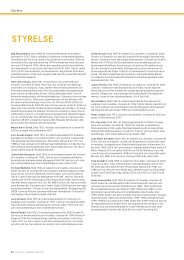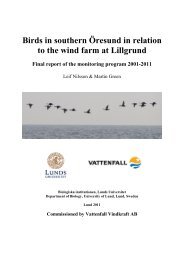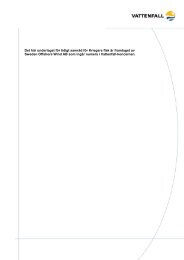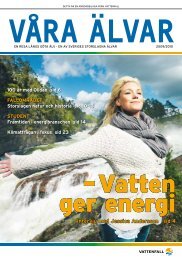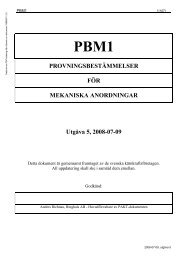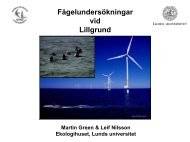Rules for qualification of NDT systems in Sweden (PDF ... - Vattenfall
Rules for qualification of NDT systems in Sweden (PDF ... - Vattenfall
Rules for qualification of NDT systems in Sweden (PDF ... - Vattenfall
You also want an ePaper? Increase the reach of your titles
YUMPU automatically turns print PDFs into web optimized ePapers that Google loves.
PBM2 Chapter 1 5(21)<br />
1 SCOPE<br />
Edition: 4<br />
Chapter 3, § 11 <strong>of</strong> SKIFS 2000:2 conta<strong>in</strong>s the follow<strong>in</strong>g about <strong>qualification</strong> <strong>for</strong> <strong>in</strong><br />
service <strong>in</strong>spection:<br />
Non-destructive test<strong>in</strong>g (<strong>NDT</strong>) <strong>of</strong> reactor pressure-vessels and mechanical components<br />
<strong>in</strong> Inspection Groups A and B shall be per<strong>for</strong>med with <strong>in</strong>spection <strong>systems</strong> which have<br />
been qualified to reliably detect, characterise and size those defects which can occur <strong>in</strong><br />
the types <strong>of</strong> components <strong>in</strong> question.<br />
The Licensee is responsible that such <strong>qualification</strong> is <strong>in</strong>vigilated and reviewed by a<br />
<strong>qualification</strong> body which is approved <strong>for</strong> the purpose by the Swedish Nuclear<br />
Inspectorate (SKI). For approval it is required that the <strong>qualification</strong> body has an<br />
<strong>in</strong>dependent and impartial status and an appropriate organisation with the necessary<br />
technical competence <strong>for</strong> the tasks <strong>in</strong> question.<br />
Regard<strong>in</strong>g <strong>in</strong>spection <strong>for</strong> repairs, manufactur<strong>in</strong>g and site erection Chapter 4, §10 <strong>of</strong><br />
SKIFS 2000:2 says: “Inspections <strong>in</strong>volv<strong>in</strong>g non destructive exam<strong>in</strong>ations shall be<br />
per<strong>for</strong>med us<strong>in</strong>g well-tried <strong>NDT</strong> applications.” The General Recommendations to this<br />
paragraph say: “When well-tried <strong>NDT</strong> applications are not available, the fitness <strong>for</strong><br />
purpose <strong>of</strong> the <strong>NDT</strong> procedures <strong>in</strong>tended to be used shall be demonstrated through<br />
relevant <strong>qualification</strong> accord<strong>in</strong>g to the pr<strong>in</strong>ciples <strong>of</strong> chapter 3, § 11……”<br />
These <strong>qualification</strong> rules (PBM 2) are the Licensee’s general specification <strong>for</strong> carry<strong>in</strong>g<br />
out <strong>in</strong>spection <strong>qualification</strong> <strong>in</strong> accordance with the regulatory requirements <strong>in</strong> SKIFS<br />
2000:2 [1], hereafter called the regulations. In addition to the regulations, it is based<br />
on the ENIQ European Methodology document [2]. PBM 2 conta<strong>in</strong>s def<strong>in</strong>itions <strong>of</strong> key<br />
concepts, <strong>in</strong>structions concern<strong>in</strong>g the allocation <strong>of</strong> tasks and responsibilities between<br />
the parties concerned, a description <strong>of</strong> the process <strong>of</strong> <strong>qualification</strong>, plus guidel<strong>in</strong>es <strong>for</strong><br />
assess<strong>in</strong>g <strong>qualification</strong>s. It also conta<strong>in</strong>s quality assurance requirements <strong>for</strong> the<br />
<strong>qualification</strong> body and basic requirements <strong>for</strong> <strong>in</strong>spectors, procedures and equipment<br />
which are to be qualified.<br />
F<strong>in</strong>ally, it is the <strong>in</strong>tention <strong>of</strong> the Licensees, that PBM 2 shall be the guid<strong>in</strong>g document<br />
<strong>for</strong> the <strong>in</strong>terpretation <strong>of</strong> the licens<strong>in</strong>g authorities regulations on <strong>in</strong>spection <strong>qualification</strong><br />
issues.<br />
As PBM 2 is a set <strong>of</strong> requirements, the contents are concentrated on what shall be done<br />
and very little on how it should be carried out. However, dur<strong>in</strong>g the 5 years that<br />
<strong>in</strong>spection <strong>qualification</strong> has been a requirement <strong>in</strong> <strong>Sweden</strong> it has become <strong>in</strong>creas<strong>in</strong>gly<br />
evident that there exists a great potential <strong>for</strong> improvement <strong>in</strong> actually carry<strong>in</strong>g out<br />
<strong>in</strong>spection <strong>qualification</strong>s. There<strong>for</strong>e <strong>in</strong> late 1999 a jo<strong>in</strong>t ef<strong>for</strong>t was launched by the<br />
nuclear utilities to thoroughly analyse the <strong>qualification</strong> process. This study was<br />
completed <strong>in</strong> mid 2000. The result is a description <strong>of</strong> how <strong>in</strong>spection <strong>qualification</strong><br />
should be carried out to be efficient while at the same time meet<strong>in</strong>g exact<strong>in</strong>g technical<br />
standards. The f<strong>in</strong>al report on the <strong>in</strong>spection <strong>qualification</strong> process (only available <strong>in</strong> the<br />
Swedish language) is attached as a support document, appendix 1.


